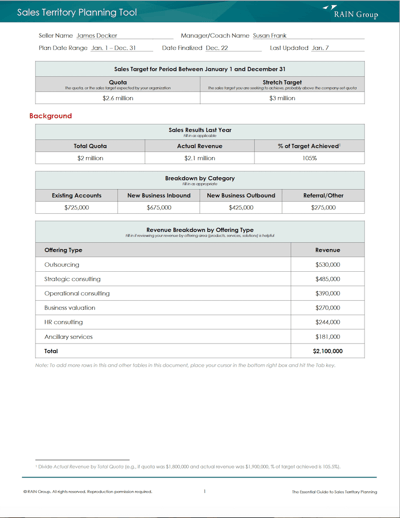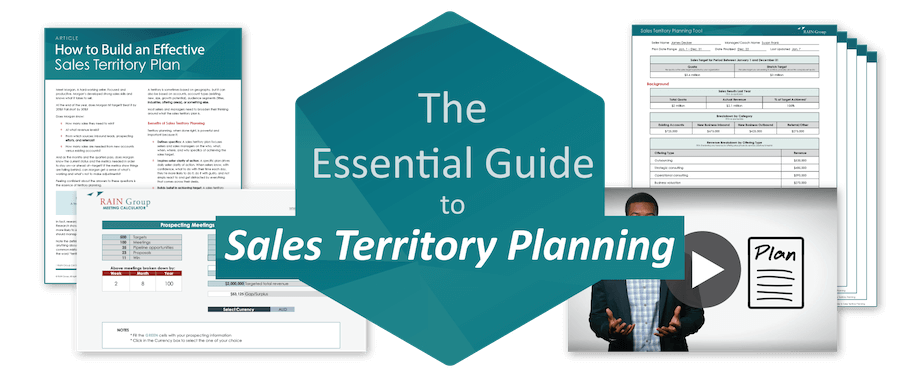Meet Morgan. A hard-working seller. Focused and productive. Morgan’s developed strong sales skills and knows what it takes to sell.
At the end of the year, does Morgan hit target? Beat it by 20%? Fall short by 30%?
Does Morgan know:
- How many sales they need to win?
- At what revenue levels?
- From which sources: inbound leads, prospecting efforts, and referrals?
- How many sales are needed from new accounts versus existing accounts?
And as the months and the quarters pass, does Morgan know the current status and the metrics needed in order to stay on—or ahead of—target? If the metrics show things are falling behind, can Morgan get a sense of what’s working and what’s not to make adjustments?
Feeling confident about the answers to these questions is the essence of territory planning.
What is a Sales Territory Plan?
A territory plan is a specific, defensible plan to achieve a sales target.
In fact, research from RAIN Group Center for Sales Research shows Top-Performing Sales Managers are 52% more likely to excel at planning and analyzing how sellers should manage their territories.
Note the definition of a territory plan doesn’t include anything about the geography the seller covers. A common mistake sellers and managers make is confusing the word “territory” with “geography.”
A territory is sometimes based on geography, but it can also be based on accounts, account types (existing, new, size, growth potential), audience segments (titles, industries, offering areas), or something else.
Most sellers and managers need to broaden their thinking around what the Sales Territory Plan is.
Benefits of Sales Territory Planning
Territory planning, when done right, is powerful and important for reasons including:
- Defines specifics: A sales territory plan focuses sellers and sales managers on the who, what, when, where, and why specifics of achieving the sales target.
- Inspires seller clarity of action: A specific plan drives daily seller clarity of action. When sellers know, with confidence, what to do with their time each day, they’re more likely to do it, do it with gusto, and not simply react to and get distracted by everything that comes across their desks.
- Builds belief in achieving target: A sales territory plan helps sellers and managers build belief that they can achieve their target. Our research shows 39% of sellers do not believe their targets are achievable—which can become a self-fulfilling prophecy. On the other hand, when sellers know what needs to happen to achieve their targets, they believe more strongly that they can achieve it.
- Align sellers to the right targets: Sales territory plans help to align sellers to the right buyers, accounts, and geographies best suited to their success before they spend months working in areas that won’t yield the best results for them.
- Allows for progress measurement and adjustment: Sales territory plans allow for analysis of whether sellers are on target and allow for thoughtful adjustment when sellers fall behind.
- Creates strategic alignment: Sellers working without a specific, defensible plan will too often take actions that lead them to a destination that’s not consistent with the company’s or team’s goals.
The outcome of a strong territory plan—along with strong weekly and daily planning to execute the plan—is seller focus, productivity, and results.
Without a specific, defensible territory plan sellers are likely to experience:
- Meandering effort, moving from task to task without a clear sense of purpose
- Lack of effort, as clear plans and actions drive motivation and productivity
- Lack of belief in their ability to achieve their goals
- Lack of ability to calibrate as conditions change, some areas don’t pan out, and they fall behind
In addition to leaving sales results to chance, the lack of a specific territory plan can also result in poor morale, defensiveness, and finger-pointing. Even more reason to double down on territory planning.
3 Key Areas of Sales Territory Planning
There are three key areas to focus on in sales territory management for both sales managers and sellers:
- Territory plan development, which focuses on producing the actionable, defensible plan
- Target setting, which is both a science and an art, and difficult to get right, but when target setting is demonstrably not right, it throws everything off
- Tracking and adjusting, which means regularly checking progress against the plan, and making necessary adjustments to achieve the goal
The territory-planning content here is for both sellers to build their own plans and for sales managers to help sellers build plans. Whether you’re doing it alone or collaboratively as a team, it’s the same process and content.
If you’re a sales manager and you need to build territory plans for your team, there’s nothing more to it than building the plans one-by-one and then viewing them together as a whole. When you do that, you can make sure the collection of individual plans will get the whole team where it needs to go, and that proper boundaries are set up so sellers don’t pursue the same targets or opportunities more often than they should.
Using a Sales Territory Planner
The outcome of a territory planning process is—you guessed it—a plan. We use RAIN Group’s Sales Territory Planner with our clients. It includes the essential components to build an effective territory plan, whether you’re a sales manager helping your team to build plans or a seller building your own.
Elements of a Sales Territory Planner
The elements of a sales territory planner include:
Sales Targets
This includes quota (the company’s target for the seller) and stretch target (the seller’s own target which may be above the company-set target).
Background
- Sales results from the previous year (total quota, actual revenue, % of target achieved)
- Breakdown by category (e.g., existing accounts, new business inbound, new business outbound, referral)
- Revenue breakdown by offering type (e.g., products, services, solutions)
- Factors contributing to the previous year’s results
- Current year plan, including targets and current weighted average pipeline
Plan to Achieve Overall Target
- Accounts, including current and plan-year revenue
- For each category (e.g., existing accounts, new business inbound, new business outbound, referral)
- # of leads needed
- # of proposals/quotes
- # of wins
- Average deal size
- Total revenue
- Targeting, specify territories including existing accounts, target accounts, geographies, industries, and audience segments
- Metrics, including:
- Lead indicators and pipeline metrics (e.g., initial meetings, conversion, proposals or quotes delivered, proposal size value, discounting %, average historical repeat business %)
- Lag indicators (e.g., sales won, average size of sale, repeat business %)
- Targets by quarter
- Metrics review, including rhythm for reviews and who will review
Plan Confidence and Commentary
- Reasons the plan is achievable
- Top priorities to achieve the plan
- Top areas for learning or improving to achieve the plan
- Top potential results derailers, including the top risks that can derail success and what you can do to mitigate
Finalizing Your Plan
The list above serves as a guide for sellers to consider what’s important to them, or for sales managers to consider on behalf of the sellers they’re helping. It’s okay to leave some sections off if they aren’t important to achieving the goal.
In any case, the desired outcome is a specific, defensible plan to achieve the goal. When it’s complete, look at the plan. Can you state confidently:
- I believe I can execute this plan
- If I execute this plan, I am confident I’ll achieve my goal
If you feel confident in your plan and are committed to executing it, sign the planner document and share it with your manager or someone you work with closely. Research has shown that people who make a commitment contract increase their chances of success.
If you don’t feel confident now, the best thing to do is to go back and work through the plan to build your confidence, and then sign it.
Then go forth and achieve your goals.
7 Tips for Successful Sales Territory Planning
People who are strong at territory planning often say, “I wish I knew what I know now several years ago, when I did this for the first time.”
Here are the key tips experienced sales managers and sellers say helped them to become skilled at territory planning.
- Use the RAIN Sales Territory Planner as a checklist. If something is important to you or your company, don’t skip it or give it short shrift.
- Build plans for yourself or your teams that give you confidence you can beat the plan by at least 20% or so. If you do, you might find yourself doing just that! If you fall short, you might still beat your quota. But if you plan for only achieving your quota and fall short of that, you don’t leave any wiggle room for success. Set your sights high and plan to achieve stretch goals.
- If numbers aren’t your area of strength, get help. You need leads, accounts, and sales wins of certain sizes to hit your goals. It’s critical to map this out. Sellers who don’t, often find themselves not even knowing they’re well behind their goals until halfway into the year and then, when it becomes evident, they can’t catch up.
-
Make assumptions that are based on reality and are defensibly achievable. For example, we’ve seen plans where sellers expect to win 65% of proposed sales. But then they find out that Top Performers at their company only average 55%.
Other times, we’ve seen sellers say they need “two new business meetings per week,” only to find out, when they play out the pipeline math, they need three. This might seem small, but if they only get two meetings each week for a year when they need three, they can find themselves hundreds of thousands of dollars—or more—short of their target. When they see they need three meetings, they change their action plans to avoid this problem.
- Consider sales cycle times. What you do for activity in the last quarter of the year might not yield until the next year. Make sure you have enough in play early enough to meet your target. If your sales cycle is longer or shorter than a quarter, plan for that.
- Once the plan is done, have someone review it and challenge it. Don’t skip this! To challenge the plan, follow these steps:
- Read the plan and ask, “On first read, does anything stand out as not logical or achievable?”
- Go through each area and ask, “Do I have confidence or doubt in this area?”
- Question each metric, such as average size of sale, win rate on proposed sales, meetings needed to fill the pipeline, revenue expected from accounts, and so on, to challenge if they are reasonable.
- Ask, regarding the whole plan, “Will the seller (or I) implement this?” If there’s a question about execution of the plan, back up and ask why.
- Ask for the whole plan, “If the seller (or I) implements this, will they be likely to achieve the goal?” If there’s a question about the likelihood the plan will work, back up and ask why.
Overall, when it comes to challenging the plan, the key is to make sure you apply intense scrutiny. It may take less than an hour for you or someone else to do it, but that hour can be the key to a whole year of success or failure.
If the territory plan stands up to scrutiny, it’s defensible. If not, then you still have some work to do to complete the plan.
-
Finally, you’re done when you believe in the plan confidently. Once you’re here, sign the plan—even if that’s just for yourself. You’re making a commitment to implement it, and you’ll hit the ground running.
On the flip side, if a seller and manager work on a plan diligently and still can’t figure out what to do to achieve the goal with reasonable likelihood, escalate the discussion. You might find a more senior manager can help you develop a plan you all can believe in.
One Final Thought
As Sun Tzu famously wrote, “Tactics without strategy is the noise before defeat.” When it comes to sales, “actions without plans” is about much the same thing. But if you have a strong plan you’re confident in, and you stay on it, you will have much stronger odds of meeting — or exceeding — your sales goal.








